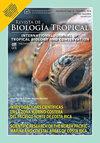Effect of seasonality on the leaf phenology and physiology of Byrsonima species (Malpighiaceae)
IF 0.6
4区 生物学
Q4 BIOLOGY
引用次数: 0
Abstract
Introduction: Defined seasonality in savanna species can stimulate physiological responses that maximize photosynthetic metabolism and productivity. However, those physiological responses are also linked to the phenological status of the whole plant, including leaf phenophases. Objective: To study how physiological traits influence phenophase timing among congeneric and co-occurring savanna species. Methods: We evaluated the leaf phenology and physiological traits of populations of Byrsonima intermedia, B. coccolobifolia, and B. verbascifolia. Physiological measurements were performed at the onset of the dry and rainy seasons and again late in the season. Results: B. intermedia and B. coccolobifolia were classified as brevideciduous and B. verbascifolia as evergreen. The maximum quantum yield for B. intermedia and B. coccolobifolia were lowest during the dry season. At the onset of the dry period, the highest chloroplastidic pigment levels were observed, which decreased as the season advanced, total chlorophyll/carotenoid ratios were lowest, and carotenoid contents were highest. We detected low starch content values at the start of the rainy season, coinciding with the resumption of plant growth. Two months into this season, the leaves were at their peak structural and functional maturity, with high water-soluble polysaccharide values and photosynthetic rates, and were storing large amounts of starch. Conclusions: Physiological and leaf phenological strategies of the Byrsonima species were related to drought resistance and acclimatization to the seasonality of savanna water resources. The oscillations of the parameters quantified during the year indicated a strong relationship with water seasonality and with the phenological status of the leaves. Objective: We studied how physiological traits, and not only seasonality, influence phenophase timing among congeneric and co-occurring savanna species. Methods: We followed the leaf phenologies and physiological traits of populations of Byrsonima intermedia, B. coccolobifolia, and B. verbascifolia native to the Brazilian savanna. Analyses of specific leaf mass, relative water content, leaf phenology, leaf carbohydrate content, chloroplastidic pigments, and photosynthetic efficiency were performed at different times during both the dry and rainy seasons. Physiological measurements were performed at the onset of the dry season and again late in that season, as well as at the onset of the rainy season and again late in the rainy season. Results: Byrsonima intermedia and B. coccolobifolia were classified here as brevideciduous and B. verbascifolia as evergreen. Few variations in chlorophyll a fluorescence values were detected over the full year, with the lowest maximum quantum yield values (Fv/Fm) for B. intermedia and B. coccolobifolia occurring during the dry season. The deciduous species (B. verbascifolia) evidenced higher photosynthetic yields during periods of abundant water availability, mainly after its complete recovery after the start of the prolonged rainy period. The highest chloroplastidic pigment levels were observed at the onset of the dry period, although chlorophyll levels decreased as the dry season advanced. The lowest total chlorophyll/carotenoid ratios and the highest carotenoid contents observed at the onset of the dry season indicated that Byrsonima plants were still investing in mechanisms of photoprotection and the dissipation of excess energy from their photosynthetic systems even under water deficit conditions. We detected low starch content values at the onset of the rainy season, which coincides with the resumption of plant growth. At two months into the rainy season, the leaves were at their peak structural and functional maturity, exhibiting high water-soluble polysaccharide values and high photosynthetic rates, and were storing large amounts of starch. Conclusions: Our data evidenced that the physiological and foliar phenological strategies of the Byrsonima species studied here were related to drought resistance and to acclimatization to the seasonality of savanna water resources. The oscillations of the parameters quantified during the year in the three studied species indicated not only a strong relationship with water seasonality, but also with the phenological statuses of the leaves.季节对松麻科松麻属植物叶片物候和生理的影响
引言:热带草原物种的季节性可以刺激生理反应,最大限度地提高光合代谢和生产力。然而,这些生理反应也与整个植物的表型状态有关,包括叶片的表型。目的:研究热带稀树草原同生种和共生种的生理性状对表型时间的影响。方法:分别对中叶、球叶和马鞭草种群的叶片酚学和生理特性进行了评价。生理测量在旱季和雨季开始时进行,并在雨季后期再次进行。结果:B。中间花B.coccolobifolia为短落叶植物,马鞭草B.verbascifolia为常绿植物。中间B.intermedia和B。球果在旱季最低。在干旱期开始时,观察到最高的叶绿体色素水平,随着季节的推移而下降,总叶绿素/类胡萝卜素比率最低,类胡萝卜素含量最高。我们在雨季开始时检测到低淀粉含量值,这与植物恢复生长相吻合。这个季节开始两个月后,叶片处于结构和功能成熟的高峰期,具有高的水溶性多糖值和光合速率,并储存了大量淀粉。结论:Byrsonima物种的生理和叶酚策略与抗旱性和对稀树草原水资源季节性的适应有关。在一年中量化的参数的振荡表明与水的季节性和叶片的酚性状态有很强的关系。目的:我们研究了生理特征,而不仅仅是季节性,如何影响同生和共生稀树草原物种的表型时间。方法:对原产于巴西热带草原的介叶夜蛾(Byrsonima intermedia)、球果夜蛾(B.coccolobifolia)和马鞭草(B.verbascifolia)种群的叶酚和生理特性进行了研究。在旱季和雨季的不同时间,对比叶质量、相对含水量、叶酚、叶碳水化合物含量、叶绿体色素和光合效率进行了分析。生理测量在旱季开始时进行,在旱季后期再次进行,以及在雨季开始时和雨季后期再次进行。结果:本文将中间叶和球叶B.coccolobifolia分类为短落叶,马鞭草B.verbascifolia为常绿。全年几乎没有检测到叶绿素a荧光值的变化,中间B.intermedia和B.coccolobifolia的最大量子产率值(Fv/Fm)最低发生在旱季。落叶种(B.verbascifolia)在水分充足的时期表现出较高的光合产量,主要是在长时间雨季开始后完全恢复之后。在旱季开始时观察到最高的叶绿体色素水平,尽管叶绿素水平随着旱季的推进而下降。旱季开始时观察到的最低的总叶绿素/类胡萝卜素比率和最高的类胡萝卜素含量表明,即使在缺水条件下,Byrsonima植物仍在投资于光保护机制和从其光合系统耗散多余能量。我们在雨季开始时检测到低淀粉含量值,此时恰逢植物恢复生长。雨季开始两个月时,叶片处于结构和功能成熟的高峰期,表现出高的水溶性多糖值和高的光合速率,并储存了大量淀粉。结论:我们的数据证明,本文研究的Byrsonima物种的生理和叶片酚学策略与抗旱性和对稀树草原水资源季节性的适应有关。在三个研究物种中,一年中量化的参数的振荡不仅表明与水的季节性有很强的关系,还表明与叶片的酚类状态有很大的关系。
本文章由计算机程序翻译,如有差异,请以英文原文为准。
求助全文
约1分钟内获得全文
求助全文
来源期刊

Revista De Biologia Tropical
生物-生物学
CiteScore
1.80
自引率
0.00%
发文量
23
审稿时长
4-8 weeks
期刊介绍:
The Revista de Biología Tropical / International Journal of Tropical Biology and Conservation is a mainstream scientific journal published since 1953 and covered by Web of Science; Science Citation Index; Current Contents; Google Scholar; Scopus, SciELO and nearly 50 additional indices.
A double blind system guarantees you a fair evaluation, and our world class editorial and scientific boards provides a first decision in three working days. The journal is Full Open Access and is widely read where your article can have the highest real impact.
Since its beginning in 1953, the Revista follows these principles: objective and independent evaluation of all manuscripts; transparency in all processes; ethical use of procedures, data, specimens and subjects; fair treatment of all parties; and absolute predominance of scientific rigor over any other aspect.
 求助内容:
求助内容: 应助结果提醒方式:
应助结果提醒方式:


